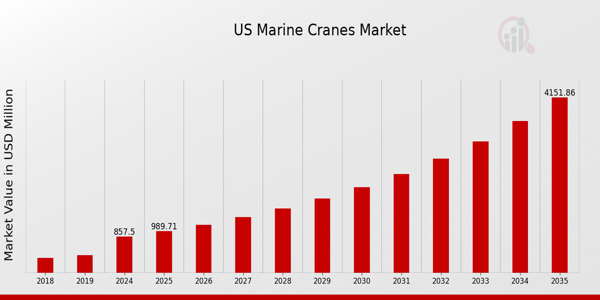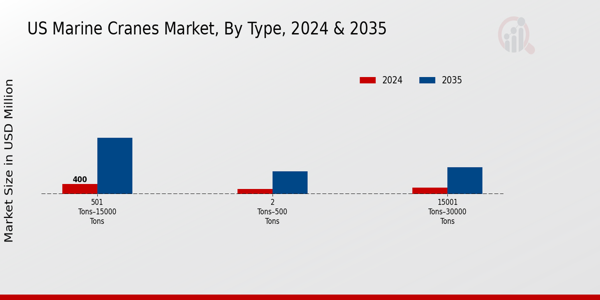US Marine Cranes Market Overview:
As per MRFR analysis, the US Marine Cranes Market Size was estimated at 801.51 (USD Million) in 2023. The US Marine Cranes Market Industry is expected to grow from 857.5(USD Million) in 2024 to 4,151.88 (USD Million) by 2035. The US Marine Cranes Market CAGR (growth rate) is expected to be around 15.418% during the forecast period (2025 - 2035).
Key US Marine Cranes Market Trends Highlighted
The US Marine Cranes Market is currently witnessing several notable trends driven by various factors. One of the key market drivers is the increasing investment in port infrastructure and expansion of maritime operations. As the United States government emphasizes enhancing its transportation network, especially in coastal areas, there is a growing demand for marine cranes to facilitate loading, unloading, and maintenance activities at ports. This trend is further bolstered by the rise in offshore oil and gas exploration, which requires advanced lifting solutions to operate efficiently and safely. Opportunities are emerging in the market as there is a pivot towards automation and smart technologies in marine operations.
The adoption of advanced monitoring systems and autonomous cranes can improve operational efficiency and safety, creating potential for manufacturers to innovate and introduce smarter crane solutions tailored to meet the needs of modern marine applications. The growing need for environmentally friendly equipment is also reshaping the market landscape, as companies aim to reduce their carbon footprint through energy-efficient crane technologies. Trends in recent times indicate that the US Marine Cranes Market is also moving towards sustainability, aligning with national initiatives to promote greener practices in the shipping and marine sectors. Regulatory pressures and customer preferences for eco-friendly options are prompting industry players to invest in research and development for innovative crane designs. Additionally, the ongoing recovery of global supply chains has spurred demand for marine cranes, as industries seek to optimize logistics and enhance operational capabilities. Overall, these dynamics present a complex yet promising environment for stakeholders in the US Marine Cranes Market.

Source: Primary Research, Secondary Research, MRFR Database and Analyst Review
US Marine Cranes Market Drivers
Rising Demand for Renewable Energy Projects
The push for renewable energy projects in the United States is a significant driver for the US Marine Cranes Market Industry. The U.S. government has set ambitious targets for renewable energy generation, aiming for 100% carbon-free electricity by 2035. This transition necessitates the construction and installation of renewable energy projects like wind farms and solar installations, often involving marine operations that require sophisticated crane technology.
According to the U.S. Energy Information Administration, the capacity of offshore wind energy is expected to grow by approximately 20 gigawatts by 2030, which will significantly increase the demand for specialized marine cranes used in the installation and maintenance of these structures. Companies like Siemens Gamesa and GE Renewable Energy are heavily investing in these projects, further leading to the demand for advanced crane solutions tailored for marine operations. The increasing focus on sustainable energy is expected to drive growth in the US Marine Cranes Market, making it a key area for investors and stakeholders.
Expansion of the Shipping and Maritime Industry
The growth of the shipping and maritime industry in the United States serves as a robust driver for the US Marine Cranes Market Industry. The U.S. ports have recorded a transportation volume increase of 2.6% annually over the past decade, according to the American Association of Port Authorities. This consistent increase in cargo throughput necessitates advanced marine cranes capable of handling larger volumes and heavier loads efficiently. Well-established entities such as A.P.Moller-Maersk and Carnival Corporation are expanding their operational capacities in U.S. waterways, thereby fueling the demand for state-of-the-art lifting equipment. Such expansions lead to an urgent requirement for modern marine cranes that can meet the operational demands of larger vessels and bulk cargo shipments, which is vital for the continued growth of the US Marine Cranes Market.
Technological Advancements in Crane Equipment
Innovations in crane technology significantly propel the US Marine Cranes Market Industry forward. The introduction of smart cranes equipped with IoT (Internet of Things) capabilities has enhanced operational efficiency and safety within marine environments. The U.S. Department of Labor indicates that the adoption of advanced technologies in construction and marine operations is expected to reduce accident rates by up to 27% over the next five years. Companies like Liebherr and Terex have pioneered several advancements, providing cranes that offer improved precision and remote monitoring features. This modernization enables companies to undertake complex marine operations while minimizing the risk associated with lifting heavy loads. The integration of such cutting-edge technology is influencing operators in the U.S. to invest in more capable marine cranes, substantially increasing market growth in the sector.
US Marine Cranes Market Segment Insights:
Marine Cranes Market Type Insights
The US Marine Cranes Market encompasses a diverse range of types that cater to various maritime and offshore applications, reflecting the industry's broad scope and adaptability. Within this market, one of the notable segments includes cranes with capacities ranging from 2 Tons to 500 Tons. This segment is crucial as it serves smaller vessels and specialized applications in shipbuilding and repair, where maneuverability and precision lifting are essential. As marine operations often require versatile equipment, this range supports a significant share of the overall marine lifting requirements, particularly in commercial fishing and yacht construction. Another important segment, consisting of cranes with lifting capacities from 501 Tons to 15000 Tons, caters to larger vessels and heavy-duty offshore projects. This range typically features more robust construction, capable of handling substantial weights that are common in the oil and gas sectors, as well as large cargo operations. The demand for this segment is primarily driven by increased offshore exploration and production activities, which necessitate heavy lifting equipment to install and maintain large structures on the seabed. The growth in this segment also indicates a broader industrial trend towards greater efficiency and power in marine lifting solutions.
The largest segment, covering capacities from 15001 Tons to 30000 Tons, plays a pivotal role in the offshore construction and maritime sectors where heavy lift operations are involved. Specialized ships, like semi-submersibles and heavy-lift vessels, often require these high-capacity cranes for executing complex and large-scale installations, including wind turbine components and oil rig structures. Companies operating within this segment face both opportunities and challenges, as the need for advanced technology and compliance with stringent safety regulations drive innovation and investment across the industry.
Overall, the segmentation of the US Marine Cranes Market reflects a nuanced landscape where each range serves a specific purpose and clientele. The expected market growth in these categories aligns with broader trends in maritime activity and offshore exploration, revealing the intricate relationships of demand between various sectors of the shipping and marine services industries. With the ongoing advancements in engineering and technology, the capabilities of these cranes are likely to continue evolving, further enhancing their significance within the marine sector. Additionally, environmental concerns and a push towards sustainability are driving the development of more efficient and eco-friendly crane technologies, which is expected to play an influential role in shaping the future landscape of the US Marine Cranes Market.

Source: Primary Research, Secondary Research, MRFR Database and Analyst Review
Marine Cranes Market Type Insights
The US Marine Cranes Market demonstrates a significant variety through its Type segmentation, which includes Knuckle Boom, Telescopic Boom, and Stick Boom cranes. The Type of crane selected can greatly influence the efficiency and versatility of marine operations. Knuckle Boom cranes are known for their ability to perform tasks in confined spaces, making them ideal for delicate lifting in narrow environments. This flexibility has established them as a preferred choice in various marine applications. On the other hand, Telescopic Boom cranes are favored for their extended reach and lifting capacity, which allows them to handle bigger loads and perform tasks that demand high precision.
Their functionality in deep-water operations where reach is paramount proves crucial for the industry. Stick Boom cranes, characterized by their simple yet robust design, excel in applications that require heavy lifting but are typically limited in their lateral movement, highlighting their effectiveness in straightforward loading and unloading tasks. The growing trend towards automation and enhancing operational efficiency is likely to further drive the demand for these crane types, as they are vital in optimizing marine logistics while navigating challenges like regulatory compliance and environmental considerations in the US Marine Cranes Market.
Marine Cranes Market Application Insights
The Application segment of the US Marine Cranes Market plays a pivotal role in enhancing the operational capabilities of various sectors, with diverse applications critical to national and economic interests. The Oil and Gas Platforms segment remains a key area, driven by ongoing exploration and production activities along the U.S. coastlines, which require sophisticated cranes for rigging and lifting operations. Additionally, the Government and Military sector underscores the importance of marine cranes in supporting naval operations and maintaining maritime infrastructure, thereby ensuring national security. Workboats and Research and Fishing Vessels are significant segments as well, with marine cranes facilitating efficient loading and unloading of equipment and catches, thus improving safety and productivity. Overall, the emphasis on advanced marine technologies and sustainability trends propels growth in these segments, as industries seek to optimize their operations while adhering to environmental regulations. The US Marine Cranes Market is set to leverage these growth drivers and address the challenges posed by fluctuating demand and technological advancements.
US Marine Cranes Market Key Players and Competitive Insights:
The US Marine Cranes Market is characterized by a competitive landscape that features a diverse array of manufacturers and suppliers, each vying for market share through innovation, quality, and service offerings. As the demand for marine-related construction, shipping, and maintenance activities continues to grow, companies are focusing on enhancing their product lines, optimizing performance, and increasing reliability to gain traction. Factors such as technological advancements, regulatory compliance, and a shift towards sustainable practices are driving companies to develop specialized solutions tailored to meet the specific needs of the marine industry. Understanding the dynamics of the competitive environment is crucial for stakeholders aiming to capitalize on emerging opportunities while navigating the challenges presented by established players and new entrants in the market.
Manitowoc has solidified its presence in the US Marine Cranes Market through a robust portfolio of solutions that cater to various marine applications. Celebrated for its cutting-edge engineering and design capabilities, Manitowoc's cranes are recognized for their high lifting capacity and reliability, which are essential attributes in challenging marine environments. The company’s strong focus on research and development allows it to advance its technological prowess, ensuring that its products remain competitive against others in the segment. Manitowoc not only invests significantly in enhancing the durability and efficiency of its cranes but also emphasizes customer service and support, fostering long-term relationships with clients. Its strategic positioning and commitment to quality have positioned Manitowoc as a leading contender within the US market, reinforcing its reputation as a preferred partner for marine construction and operational needs.
Palfinger has emerged as a significant player in the US Marine Cranes Market, specializing in a wide range of innovative lifting solutions. The company offers high-performance marine cranes designed to meet the rigorous demands of marine operations, and its products are widely used in various segments, including commercial shipping and offshore activities. Palfinger's strengths lie in its commitment to developing state-of-the-art, durable cranes that combine both functionality and ease of operation. Recent mergers and acquisitions have bolstered Palfinger's capabilities, enabling it to expand its technological reach and enhance its market presence. The company's focus on operational efficiency and potential for customized solutions has made it a sought-after partner in the marine sector, ensuring its continued relevance among competitors. With a reputation for delivering exceptional products and services, Palfinger continues to be a formidable entity within the US Marine Cranes Market.
Key Companies in the US Marine Cranes Market Include:
- Manitowoc
- Palfinger
- JMG
- Tadano
- Furukawa
- XCMG
- Mack
- SANY
- Grove
- Cargotec
- Terex
- Konecranes
- Doosan
- Hitachi
- Liebherr
US Marine Cranes Market Industry Developments
In October 2023, the US Marine Cranes Market has seen significant developments, particularly with companies like Manitowoc, Palfinger, and Tadano making strides in innovation and technology enhancements to meet increasing demand for advanced marine lifting solutions. The market is currently experiencing growth due to rising investments in offshore wind energy and infrastructure projects, which have expanded the utilization of marine crane systems. Manitowoc has notably improved its product line, enhancing operational efficiency, while Palfinger has focused on sustainability by integrating eco-friendly technologies into its crane designs. Recent competitive dynamics include merger and acquisition activities, with Furukawa acquiring specialized assets from a smaller US-based competitor in September 2023, aligning with their strategic expansion plans.
Companies such as Liebherr and Terex have also reported a boost in market valuation, reflecting a growing trend of modernization within the sector. Recent regulations from the US Coast Guard have emphasized safety and operational standards, further influencing industry practices. Additionally, XCMG’s entry into the market in late 2022 has intensified competition, providing diverse options for customers and driving forward innovation across the sector.
US Marine Cranes Market Segmentation Insights
Marine Cranes Market Type Outlook
- 2 Tons–500 Tons
- 501 Tons–15000 Tons
- 15001 Tons–30000 Tons
Marine Cranes Market Type Outlook
- Knuckle Boom
- Telescopic Boom
- Stick Boom
Marine Cranes Market Application Outlook
- Oil & Gas Platforms
- Government & Military
- Workboats Research & Fishing Vessels
- Research & Fishing Vessels
| Report Attribute/Metric Source: |
Details |
| MARKET SIZE 2023 |
801.51(USD Million) |
| MARKET SIZE 2024 |
857.5 (USD Million) |
| MARKET SIZE 2035 |
4151.88 (USD Million) |
| COMPOUND ANNUAL GROWTH RATE (CAGR) |
15.418% (2025 - 2035) |
| REPORT COVERAGE |
Revenue Forecast, Competitive Landscape, Growth Factors, and Trends |
| BASE YEAR |
2024 |
| MARKET FORECAST PERIOD |
2025 - 2035 |
| HISTORICAL DATA |
2019 - 2024 |
| MARKET FORECAST UNITS |
USD Million |
| KEY COMPANIES PROFILED |
Manitowoc, Palfinger, JMG, Tadano, Furukawa, XCMG, Mack, SANY, Grove, Cargotec, Terex, Konecranes, Doosan, Hitachi, Liebherr |
| SEGMENTS COVERED |
Type, Type, Application |
| KEY MARKET OPPORTUNITIES |
Emerging renewable energy projects, Increased defense spending, Growth in offshore oil exploration, Advancements in crane technology, Enhanced safety regulations compliance |
| KEY MARKET DYNAMICS |
Growing offshore oil and gas industry, Increasing defense spending, Technological advancements in crane design, Demand for sustainable solutions, Aging marine infrastructure replacement |
| COUNTRIES COVERED |
US |
Frequently Asked Questions (FAQ) :
The US Marine Cranes Market is expected to be valued at 857.5 million USD in 2024.
By 2035, the US Marine Cranes Market is anticipated to reach a value of 4151.88 million USD.
The expected CAGR for the US Marine Cranes Market from 2025 to 2035 is 15.418%.
By 2035, the 501 Tons–15000 Tons segment is anticipated to reach a value of 2200.0 million USD, making it a dominant type in the market.
The 2 Tons–500 Tons crane segment is expected to be valued at 900.0 million USD by 2035.
Key players in the US Marine Cranes Market include Manitowoc, Palfinger, JMG, Tadano, and Furukawa.
The 15001 Tons–30000 Tons segment is projected to reach a value of 1051.88 million USD by 2035.
Growth drivers for the US Marine Cranes Market include increasing marine construction activities and advancements in crane technology.
Applications in shipping, offshore oil and gas exploration, and marine construction are driving demand in the US Marine Cranes Market.
The global economic scenario has created both opportunities and challenges affecting the growth and investment in the US Marine Cranes Market.















